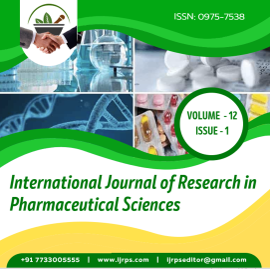Abstract
The use of therapeutic agents in medicine has lead to the development of resistant strains of many pathogens. As an alternative medicine, many herbal formulations were introduced. From ancient times, various medicinal plants have been used as a treatment agent for various diseases due to their alarming herbal properties. Turmeric, a rhizome of curcumin long a is one among them which has anti-infective and anti-inflammatory properties. Due to its novel properties, it is used in various treatments options for oral health and systemic health. Curcumin, due to its complex interaction between inflammation, immunity and oxidative stress, it was used in various oral and neck pathologies also apart from general health benefits. Curcumin suppresses pro-inflammatory cytokines in head and neck pathologies showing various changes in salivary Ph and salivary stress biomarkers. In dentistry, curcumin has been proved to have antiplaque efficiency in various studies, but long term study is required to substantiate its properties. Recently nanostructured lipid carrier containing curcumin was used in dentistry to bring about bone regeneration. This article depicts various properties, applications of curcumin in healthcare and its pharmacological action for systemic and oral health.
Full text article
References
Agarwal, N., et al. 2014. Evaluation of efficacy of turmeric in management of oral submucous fibrosis. Journal of Indian Academy of Oral Medicine and Radiology, 26(3):260–263.
Al-Musawi, S. 2015. Folated-nanocarrier for curcumin drug delivery in breast cancer therapy. Engineering and Technology Journal, 33(9B):1643–1654.
Alok, A., et al. 2015. Curcumin-pharmacological actions and its role in oral submucous fibrosis: a review. Journal of clinical and diagnostic research: JCDR, 9(10):ZE01–ZE03.
Baum, L., Ng, A. 2004. Curcumin interaction with copper and iron suggests one possible mechanism of action in Alzheimer’s disease animal models. Journal of Alzheimer’s Disease, 6(4):367–377.
Borra, S. K., et al. 2014. Effect of curcumin against oxidation of biomolecules by hydroxyl radicals. Journal of Clinical and Diagnostic Research: JCDR, 8(10):CC01–CC05.
Chainani-Wu, N. 2003. Safety and Anti- Inflammatory Activity of Curcumin: A Component of Tumeric (Curcuma longa). The Journal of Alternative and Complementary Medicine, 9(1):161–168.
Chattopadhyay, I., et al. 2004. Turmeric and curcumin: Biological actions and medicinal applications. Current Science-Bangalore, 87(1):44–53.
Chaudhari, A. U., et al. 2011. Comparative Evaluation of Turmeric and Chlorhexidine Gluconate Mouthwash in Prevention of Plaque Formation and Gingivitis: A Clinical and Microbiological Study. The Journal of Contemporary Dental Practice, 12(4):221–224.
Cohly, H., et al. 2003. Effect of Antioxidant (Turmeric, Turmerin and Curcumin) on Human Immunodeficiency Virus. International Journal of Molecular Sciences, 4(2):22–33.
Das, A. D., et al. 2010. Comparative Study of the Efficacy of Curcumin and Turmeric Oil as Chemopreventive Agents in Oral Submucous Fibrosis: A Clinical and Histopathological Evaluation. Journal of Indian Academy of Oral Medicine and Radiology, 22:88–92.
Dovigo, L. N., et al. 2013. Curcumin-mediated photodynamic inactivation of Candida albicansin a murine model of oral candidiasis. Medical Mycology, 51(3):243–251.
Ganjali, S., et al. 2014. Investigation of the Effects of Curcumin on Serum Cytokines in Obese Individuals: A Randomized Controlled Trial. The Scientific World Journal, 2014:1–6.
Goel, A., et al. 2001. Specific inhibition of cyclooxygenase-2 (COX-2) expression by dietary curcumin in HT-29 human colon cancer cells. Cancer Letters, 172(2):111–118.
Haruhiko, F., Kouichi, S. 2007. Dental Plaque Detection System And Dental Plaque Detection Method. Pages: 1-27.
Joe, B., et al. 2004. Biological Properties of Curcumin-Cellular and Molecular Mechanisms of Action. Critical Reviews in Food Science and Nutrition, 44(2):97–111.
Khoury, E. E., et al. 2015. Green synthesis of curcumin conjugated nanosilver for the applications in nucleic acid sensing and anti-bacterial activity. Colloids and Surfaces B: Biointerfaces, 127(1):274– 280.
Kim, Y. S., et al. 2007. Curcumin Attenuates Inflammatory Responses of TNF-??-Stimulated Human Endothelial Cells. Journal of Cardiovascular Pharmacology, 50(1):41–49.
Moghadamtousi, S. Z., et al. 2014. A Review on Antibacterial, Antiviral, and Antifungal Activity of Curcumin. BioMed Research International, pages 1–12.
Mozioglu, E., et al. 2008. Biological activity of curcuminoids isolated from Curcuma longa. Records of Natural Products, 2(1):19–24.
Murgia, D., et al. 2020. Development of a Multifunctional Bioerodible Nanocomposite Containing Metronidazole and Curcumin to Apply on L-PRF Clot to Promote Tissue Regeneration in Dentistry. Biomedicines, 8(10):425.
Neelakantan, P., et al. 2013. Effectiveness of curcumin against Enterococcus faecalis biofilm. Acta Odontologica Scandinavica, 71(6):1453–1457.
Panahi, Y., et al. 2015. Antioxidant and anti- inflammatory effects of curcuminoid-piperine combination in subjects with metabolic syndrome: A randomized controlled trial and an updated meta-analysis. Clinical Nutrition, 34(6):1101–1108.
Park, E.-J., et al. 2000. Protective Effect of Curcumin in Rat Liver Injury Induced by Carbon Tetrachloride. Journal of Pharmacy and Pharmacology, 52(4):437–440.
Prucksunand, C., et al. 2001. Phase II clinical trial on the effect of the long turmeric (Curcuma longa Linn.) on the healing of a peptic ulcer. Southeast Asian journal of tropical medicine and public health, 32(1):208–215.
Ramprasad, C. 1957. Curcuma logna and bile secretion-Quantitative changes in the bile constituents induced by sodium curcumin. J Sci Industr Res, 16:108–110.
Rangel-Castañeda, I. A., et al. 2019. Curcumin Attenuates the Pathogenicity of Entamoeba histolytica by Regulating the Expression of Virulence Factors in an Ex-Vivo Model Infection. Pathogens, 8(3):127.
Ravindranath, V., Chandrasekhara, N. 1980. Absorption and tissue distribution of curcumin in rats. Toxicology, 16(3):259–265.
Snow, J. M. 1995. Curcuma longa L. Zingiberaceae). Protocol J Botan Med, 1:43–46.
Sotomil, J. M., et al. 2019. Curcumin—A Natural Medicament for Root Canal Disinfection: Effects of Irrigation, Drug Release, and Photoactivation. Journal of Endodontics, 45(11):1371–1377.
Suhag, A., et al. 2007. Role of curcumin as a subgingival irrigant: a pilot study. Periodontal Practice Today, 4(2):115–121.
Wahlström, B., Blennow, G. 1978. A study on the fate of curcumin in the rat. Acta pharmacological et toxicological, 43(2):86–92.
Yeon, K. Y., et al. 2010. Curcumin Produces an Antihyperalgesic Effect via Antagonism of TRPV1. Journal of Dental Research, 89(2):170–174.
Authors

This work is licensed under a Creative Commons Attribution-NonCommercial-NoDerivatives 4.0 International License.

